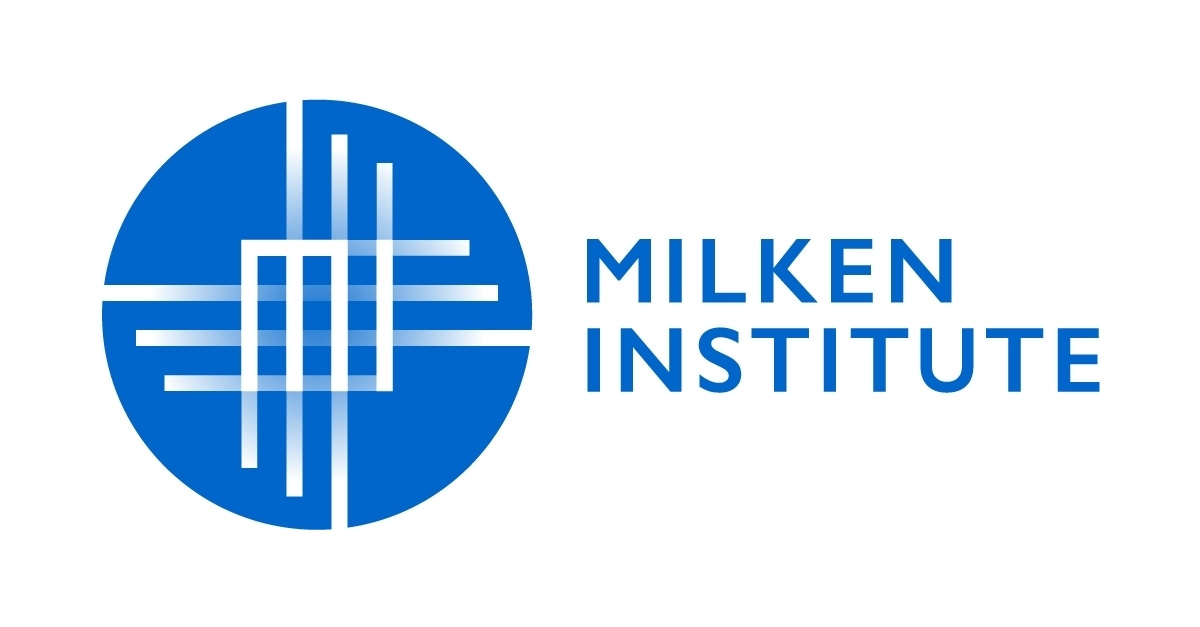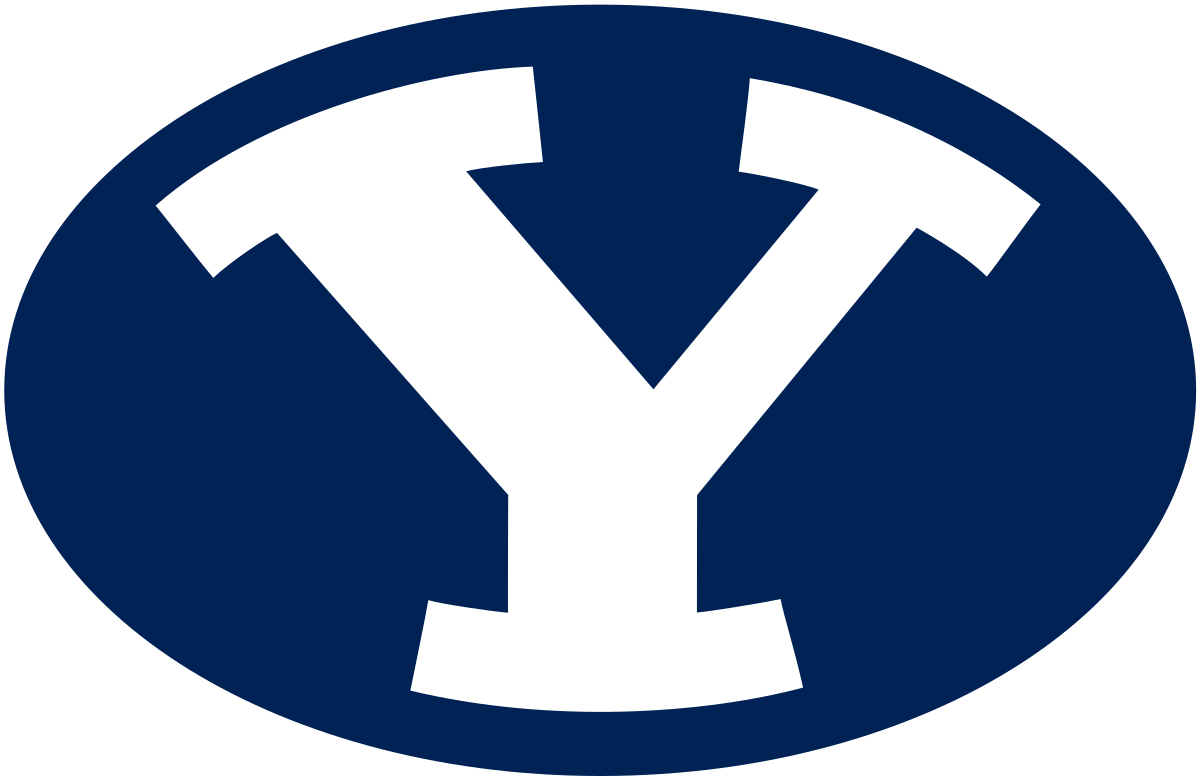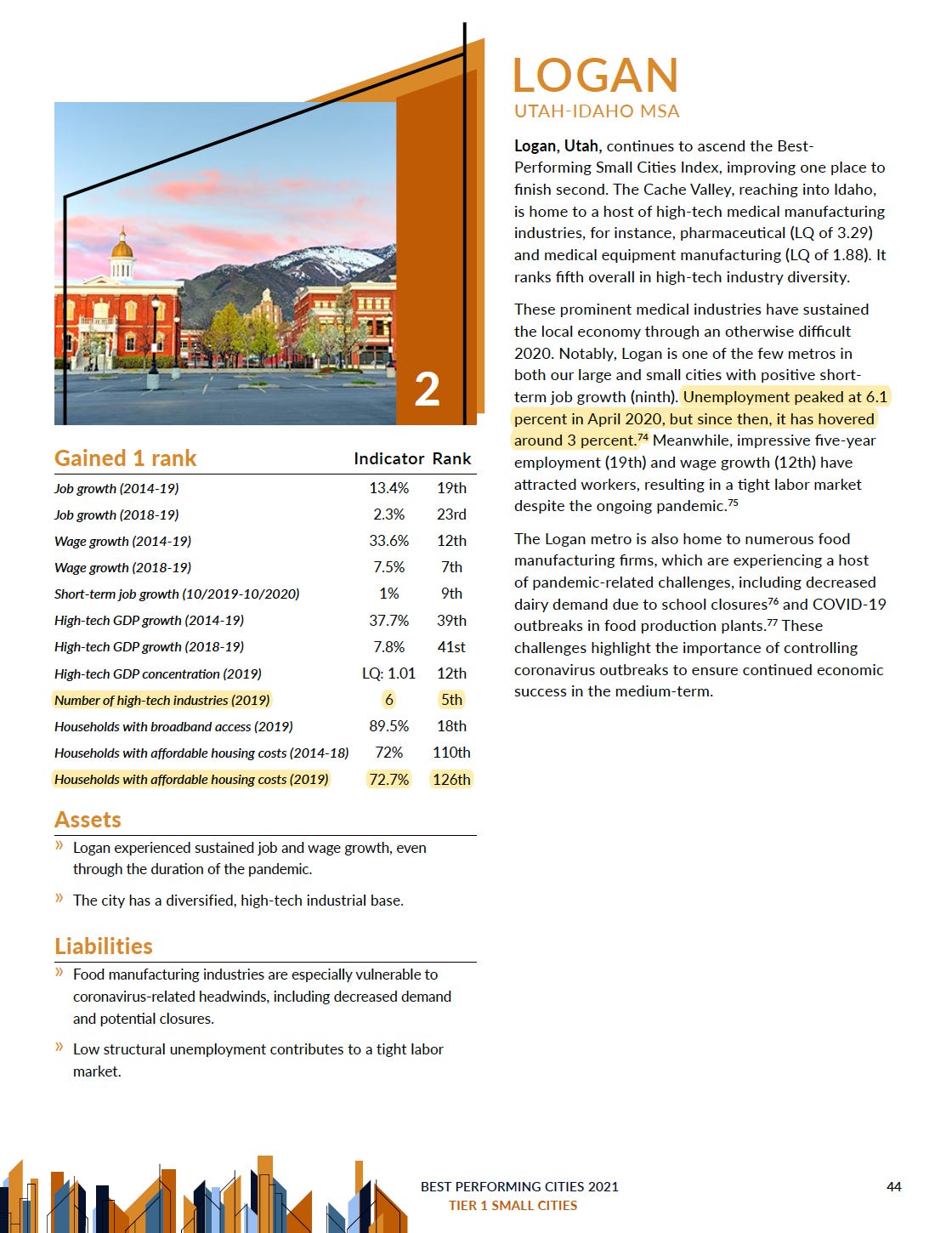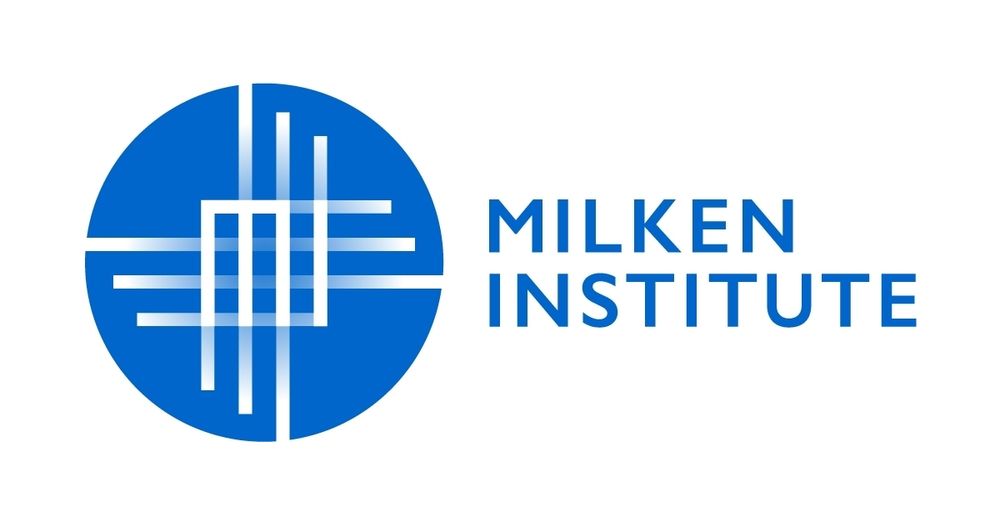The undersized, flyover state of Utah has done it again, landing 5 of its cities in the Milken Institute’s Best-Performing Cities 2021 Report. What does Utah have that comparably sized states do not?
It seems it happens so often it’s almost second-nature. Humdrum even.
For example
- Utah Ranked as the Most Charitable State, WalletHub, Nov. 2020
- Utah’s EconomyRanked Best in the U.S., 24/7 WallSt.com, Aug. 2020
- Utah Ranked as the Most IndependentState, WalletHub, June 2020
- Utah Ranked as the No. 3 State for its “Business Birth Rate,” U.S. News & World Report, Dec. 2019
- The Undergrad and Graduate Entrepreneur Programs at both BYU and the University of Utah Rank in the Top 25 Worldwide, Entrepreneur Magazine, Nov. 2019
And then it happened again yesterday:
A prestigious organization has recognized Utah for its outstanding-ness once again.
In this case, it was the Milken Institute (a nonprofit, nonpartisan think tank), with its Best-Performing Cities 2021 Report.

Specifically, in this year’s Report, three Utah cities make the Milken Institute’sTop 10 of “Large Cities” in the United States:
- Provo/Orem (ranked No. 1)
- Salt Lake City (ranked No. 4)
- Ogden/Clearfield (ranked No. 9)
But that’s not all.
The Report also ranked two of Utah’s smaller cities in the Top 10 of “Small Cities” in the U.S.:
- Logan (ranked No. 2)
- St. George (ranked No. 4)
So, yes, when measured across both Large and Small Cities in the U.S., Utah comes out with five different MSAs (Metropolitan Statistical Areas) ranked in the Top 10, respectively.
Contextually, although two other states — Idaho and Florida — have a combined total of three Large and Small Cities ranked in the two Top 10’s in this year’s Report, respectively, no other state has more than one large MSA in the Top 10 of Large Cities.
{NOTE: By way of background, large MSAs are those cities with over 250,000 residents; small MSAs are those with between 60,000 and 250,000 residents.}
Before I dig into the specifics that the Milken Institute used to rank five of Utah’s cities in their respective Top 10 lists, what’s changed?
To be clear, this is not a rhetorical question, because my recollection of when I attended BYU back in the 1970s and 1980s, Utah was typically considered little more than a flyover state, the home of the Tabernacle Choir, Donnie & Marie, and little else.
So what has changed?
What’s Made Utah into a “Pretty Great State?”
If we go back 50 years to 1970, the U.S. Census pegged Utah’s population at just over 1 million people (1,059,273 to be exact).
Conversely, the latest estimates project Utah’s population at close to 3.2 million, a threefold increase in half a century.
But population growth alone does not account for Utah’s steady rise to global destination from what used to be something people gawked at as they drove through or flew over its landscape.
From my perspective, much of the uplift can be traced back to the still growing impact of both the University of Utah and BYU.
For example, although Silicon Slopes is a commonly used phrase today to refer to the state’s exploding technology community, prior to the mid-1970s there really was no tech industry in Utah per sé.
And yet the UofU was truly the birthplace of computer graphics, led by such notable luminaries in the 1970s and 1980s as Drs. David Evans and Ivan Sutherland (of Evans & Sutherland fame), John Warnock (founder of Adobe), and Ed Catmull (co-founder of Pixar).

Other Ute alumni also made dramatic contributions to the world of computing and technology in the same timeframe, including Jim Clark (founder of both Netscape and Silicon Graphics), Nolan Bushnell (seen by many as the father of computer gaming and the co-founder of Atari), Alan Kay (the father of Object-Oriented Programming), and Thomas Stockham (the father of digital recording).
And although born in 1968 with an allocation of over 300 acres of land by the state legislature, the Research Park at the University of Utah has blossomed into a biotech/tech center in the foothills above Salt Lake City unrivaled in the state.
Conversely, out of Provo we saw the birth of mass market word processing (courtesy of Alan Ashton and Bruce Bastian, co-founders of WordPerfect), the emergence of computer networking via Novell (led by Weber State grad, Ray Noorda, with technology developed by four former students of BYU), as well as the world’s first digital hearing aid.
Additionally, Ray became one of the first angel and venture capital investors in the state, backed by his Noorda Family Trust and then the Canopy Group.

As it turns out, BYU and the UofU have also developed very successful technology transfer processes and procedures, so much so that they consistently rank among the Top Three such programs nationwide.
Although the UofU and BYU often get much of the attention, academically, in the state, Utah State University is arguably the top Agricultural university in the U.S., while Washington Monthly ranked USU as the No. 10 public university in the U.S. in 2020 (based upon social mobility, research, and promoting public service).
Additionally, don’t forget that 50 years ago Utah Valley University was a podunk, afterthought of a technical school housed in rundown facilities across the street from BYU’s Helaman Halls. But not anymore as UVU has experienced so much explosive growth it now has the largest student body within the state (by nearly one-third). And it’s still growing.
From the standpoint of entertainment and social relevance, it is also hard to overlook the impact on Utah of the now more than 40-year history of the Sundance Film Festival (and the cadre of competing Remora-like festivals).

The mid-1980s formation of the Salt Lake City-based nonprofit Wayne Brown Institute (renamed today as VentureCapital.org) also served as a huge catalyst for the education and support of emerging entrepreneurs on the nuances of raising venture capital and investor dollars.
Hollywood was also taken by surprise two decades ago by the unexpected flowering of the BYU Center for Animation as a world-class film, animation, sound and gaming mecca, but no longer.
Additionally, a clear watershed moment for Utah was its breakthrough turn as host of the wildly successful 2002 Winter Olympics.
At the same time, not only does Utah have the “Greatest Snow on Earth,” it now has the largest ski resort in America (Park City Mountain Resort).
And given the journalist/media property in question, Utah frequently has five resorts (Alta, Deer Valley, PCMR, Snowbasin, and Snowbird) listed among the top skiing/snowboarding destinations in the U.S. (depending upon personal preference and criteria).
Each of these endeavors and recognitions, along with hundreds of others (some minor, others more significant), have contributed to make Utah both more visible and more attractive to the outside world, helping the state to become more of a destination and less of an afterthought.
Utah’s Best-Performing “Large Cities” of 2021
Getting back to the latest accolades for the state, however, in the Large Cities category of the Milken Institute’s Best-Performing Cities 2021 Report, Provo/Orem comes in ranked as No. 1 (in part) because this MSA came in first place in the
- Overall Job Growth, and
- Wage Growth segments (over the past year and the prior five years).
The Provo/Orem MSA’s worst segment ranking was in Affordable Housing, coming in 61st for 2019 and 93rd for the 2014—2018 period.

Additionally, Salt Lake City ranked at No. 4 in the Large Cities category, with decent rankings across all individual segments measured by the Milken Institute.
However, the Report notes that Affordable Housing costs for 2019 for the capital city edged up to a ranking of 79th in the Large Cities category, something the Report writers saw as troubling.
The last of Utah’s three Large Cities ranked in the Top 10 was Ogden/Clearfield at No. 9.
The Milken researchers noted that Ogden/Clearfield snagged three Top 5 segment rankings among the Large Cities cohort at
- 2nd Place for Short-Term Job Growth (Oct. 2019 through Oct. 2020),
- 2nd Place for Households with Broadband Access, and
- 3rd Place for Affordable Housing costs.
Conversely, Ogden/Clearfield’s lowest segment ranking was 115th for High-tech GDP Growth, which is somewhat concerning.
Utah’s Best-Performing “Small Cities” of 2021
In the Small Cities category of the Milken Institute’s Best-Performing Cities 2021 Report, Logan, Utah comes in ranked as No. 2 (in part) because this MSA landed three Top 10 segment rankings:
- 5th Place for Number of High-Tech Industries,
- 7th Place for Wage Growth (2018—2019), and
- 9th Place for Short-term Job Growth (Oct. 2019—Oct. 2020).
Where the Logan MSA fell short, however, was in the Affordable Housing Costs segment where it garnered a 126th place finish.

The second of Utah’s two Small Cities ranked in the Top 10 was St. George at No. 4.
Interestingly, St. George snagged two 1st Place segment rankings, one each for
- Job Growth, and
- Wage Growth.
That said, St. George also finished near the bottom of all Small Cities included in the Report as it came in at 167th Place for Number of High-Tech Industries with a segment indicator of zero. Ouch!
What It All Means
At the end of the day, besides a bit of chest-puffing, back-slapping or high-fiving in certain governmental offices or Ivory Towers across the state, such rankings actually do little to support, boost, or curtail the day-to-day output, successes and/or failures of the entrepreneurs and Rank & File workers throughout the state.
{NOTE: This is unlike the euphoria many Utah Jazz fans currently feel knowing that their team has the best record in the NBA and currently has the highest predictor score to reach the NBA Finals.}
Nevertheless, will this latest set of Milken rankings be used to attempt to lure/persuade the wandering eye of a business executive contemplating moving to Utah? Without a doubt, especially if a possible Post-Performance Tax Credit is in the offing as well.
And to be clear about this, I am NOT opposed to Post-Performance Tax Credits; they’re just part of the game played in economic development circles.
But when it comes to actual results, awards and past recognition do NOT lead to future success. Only current effort can do that.
But based upon the current results I’m seeing throughout Utah’s business community, I am very encouraged for the future of Utah.
NOTE: This article was originally published by Deseret Business Watch. A few minor editorial changes have been made with this version to better match the current Silicon Slopes writing style.








